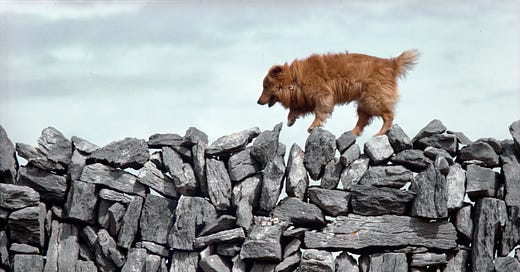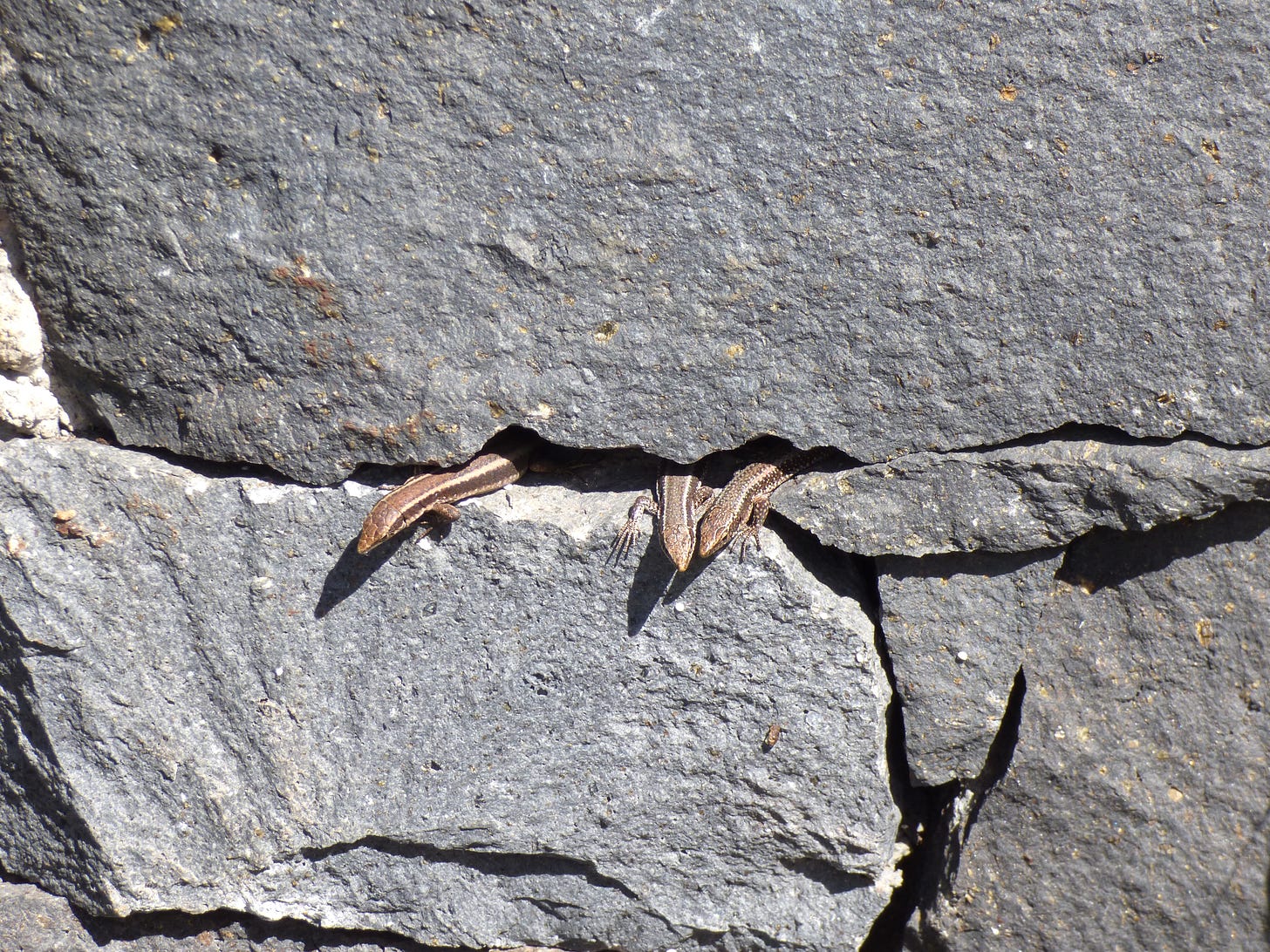By Richard Conniff
I like stone walls. That is, I like dry-stone walls, with locally available stones carefully set in place by a farmer or mason, and held there by friction and gravity, not cement. “One stone on two and two stones on one,” said a wall-builder on Inisheer in the Aran Islands, explaining the craft to me. Then he demonstrated with cigarette packs laid out on the bar where we were having a pint.
That simplistic algorithm notwithstanding, dry-stone walls can be an art form, with a skillful builder contemplating the angled irregularities of each stone to find the exact right place in a wall, to stand perhaps for centuries. It’s like a poet finding the right word and where to use it. In the walls, the Irish folklorist E. Estyn Evans once wrote, “the unlettered countryman wrote his runes on the land …”
I like these walls enough that I once spent months traveling in Ireland to write a book about them, with photographs by Alen MacWeeney. (It’s out of print now, after several editions, so don’t bother looking for it. But that shadowy figure on the cover is me.)
I suppose I could have stayed home in Connecticut and written a book about the stone walls of New England, because they are everywhere here, too. On the drive home the other night, I counted 35 dry stone walls just in the two miles from the main road to my house. The tumbledown remains of field walls also reveal the old farming and sheep-herding landscape in the woods where I hike.
But it was the West of Ireland that first got me thinking about stone walls. The deforested green fields there made the incredible abundance of walls light up for me like an intricate neural network laid out across the countryside. And in the mid-1980s, there were still good stories to be found about how the rural Irish had shaped the landscape with their walls, and the walls in turn had shaped their lives. One detail that stays with me: On Inishmaan, another of the Aran Islands, families used to bury their unbaptized newborns in border walls between properties, as if to embed in stone their belief that such children go neither to heaven nor hell, but to limbo.
I’m thinking about this now because, looking back on that book, what surprises me is how completely I ignored the plants, insects, lizards, stoats, and other life forms that make the walls their homes and their highways. I’m not alone in this. Ecologists like to celebrate hedgerows as critical habitat sustaining life in rural landscapes. But with few exceptions, they have largely failed to apply this thinking to dry-stone walls.
Even the lichen that paint themselves in varied colors across every stone wall are more alive, and more interesting, than we tend to assume. Lichen isn’t a single organism, of course, but a community, a fungus pairing up with algae or cyanobacteria, and neither side able to live without the other. The fungus depends on its photosynthesizing partner (also called a photobiont) to provide essential energy. The photobionts in turn seem to need the fungus for structure and shelter. It’s one of those mutual partnerships I’ve mentioned before on this site.
In the past, says University of Connecticut lichenologist Bernard Goffinet, researchers were limited to understanding lichens based on their outward appearance. Among other challenges with this approach, some lichens are “basically cemented to the rock,” he says. “You cannot collect the lichen without removing a portion of the rock.”
The belief using the old methodology was that one fungus and one photosynthetic organism made a lichen. But genetic analysis has revealed instead that a fungus may switch from an alga to a cyanobacterium, or back again, or partner with both at the same time, to adapt to different environments. It may modify its metabolism to produce chemical compounds that protect its partner from harmful UV radiation, parasites, or predators. Different lichens—and there are 20,000 kinds worldwide—may practice chemical warfare against neighbors to claim a habitat. And that’s not even talking about the various functions of the lichen microbiome. “So it can be a very complex relationship,” says Goffinet.
Lichens also help to begin the life of the stone wall as a habitat. By their living and dying, they form pockets of soil where grasses, ferns, and flowering plants can take root. Ants, centipedes, and beetles begin to colonize the wall. Solitary bees and wasps make their nests in the crevices and gaps between rocks. As the wall ages, snails move in, and certain butterfly and moth caterpillars may appear (some of them to feed on lichens).
Predators gravitate to stone walls both for prey and for shelter. Pete Picone, a wildlife biologist for the state of Connecticut, once watched a chipmunk run up to a wall and dive into a convenient bolthole, with a bobcat in hot pursuit. “Then the bobcat just stood there stalking it, staring at where it went into the stone wall,” Picone recalls. “Another time—actually I observed this twice—I watched a fisher walk on the stone wall, looking through the crevices for opportunities to pick out a mouse or anything that would be hiding in the wall.” Snakes and salamanders are frequent residents of stone walls, and Picone has also seen cottontail rabbits and groundhogs sheltering in burrows in the soil beneath walls. Gray squirrels use the tops of walls, he says, “as an easy way to get long distances without making a lot of noise” in the leaves. Birds swoop in to pick off caterpillars and snails.
I see that I started with Ireland and am now writing too much about Connecticut. But no place has a monopoly on walls. In the central Mexican state of Michoacán, for instance, Mexican mud turtles flourish in wet season freshwater lakes. But some of them wait out the eight-month-long dry season, according to Rodrigo Macip at the National University of Mexico, in cool dark gaps in the stone walls, which local farmers have built to contain their cattle. In Portugal, Madeira Island lizards make their home in stone walls and slip out to bask on little balconies in sunny weather. It suits them: One study found that these small lizards crowd the walls at a rate of about eight lizards—and in some places more than 20—per square meter.
The point is that stone walls are an overlooked biodiversity hotspot. The scale of them—sometimes estimated at more than 100,000 miles in New England, and 250,000 miles in Ireland—calls out for greater attention. And they are getting it, in a limited way. After being petitioned by eight European nations—Croatia, Cyprus, France, Greece, Italy, Slovenia, Spain and Switzerland, with Ireland belatedly added just last week—UNESCO acknowledged “the art of dry-stone walling” in 2018—but only as part of “the Intangible Cultural Heritage of Humanity.”
That may leave it to amateur naturalists to pay attention to stone walls as part of our natural heritage, and to professional ecologists wondering what to study next. (Proposed hypothesis: that the walls provided refuge for species deprived of all other normal habitat during periods of deforestation, like nineteenth-century New England, or Greece from ancient times onward.)
The walls may also need our attention in one other, more practical, way, according to an article earlier this year in the Anthropological Journal of European Cultures: “A very old wall that has collapsed … no longer offers sufficient cover, nooks or crannies. The walls that offer the greatest diversity of affordances to insects and animals tend therefore to be old but not too old.” In New England, after 150 years of agricultural abandonment, a season of mending walls, as Robert Frost suggested, may be overdue.
“Good fences make good neighbors,” was the phrase Frost used in his celebrated poem. But this time around, we need to think about “neighbors” much more broadly.
Richard Conniff’s books include The Species Seekers: Heroes, Fools and the Mad Pursuit of Life on Earth (W.W. Norton), Spineless Wonders: Strange Tales of the Invertebrate World (Henry Holt), and Swimming with Piranhas at Feeding Time—My Life Doing Dumb Stuff with Animals (W.W. Norton). He is a former contributing opinion writer for The New York Times, and a National Magazine Award-winning feature writer for Smithsonian, National Geographic, The Atlantic, and other publications.
Other Reading
Stone by Stone: the magnificent history in New England's stone walls, by Robert M. Thorson
Exploring Stone Walls: a field guide to stone walls, by Robert M. Thorson
“Drystone Wall,” by John Curtis, a poet in The Cotswalds, from 2018.
“Quiet Morning,” by Elizabeth Bohm, from 1938.
Irish Walls, by Richard Conniff with photos by Alen MacWeeney, and good luck finding it.
Ireland: Stone Walls and Fabled Landscapes by Alen MacWeeney and Richard Conniff (a different publisher’s reversioning, also very scarce)







“The deforested green fields … made the incredible abundance of walls light up for me like an intricate neural network….” That’s a keeper! HNY!
Lovely post.
Highly recommend "Stone by Stone," which was my father's sole reference in building a low dry-stack wall in his back yard in Colebrook. He used stones that he scavenged--slowly, over months--from toppled walls on walks in the woods.
Stone walls can be regionally specific. If you drive from west of Hartford to Westerly, you leave the retaining walls of purple siltstone, with their spots of bright yellow lichen, that are so characteristic of this part of the CT River valley. You'll know you've made it to the shore, driving down Allyn Street, when you smell the sea marsh air and see those peculiar flat-topped walls, capped by huge stones hewn into large rectangles.